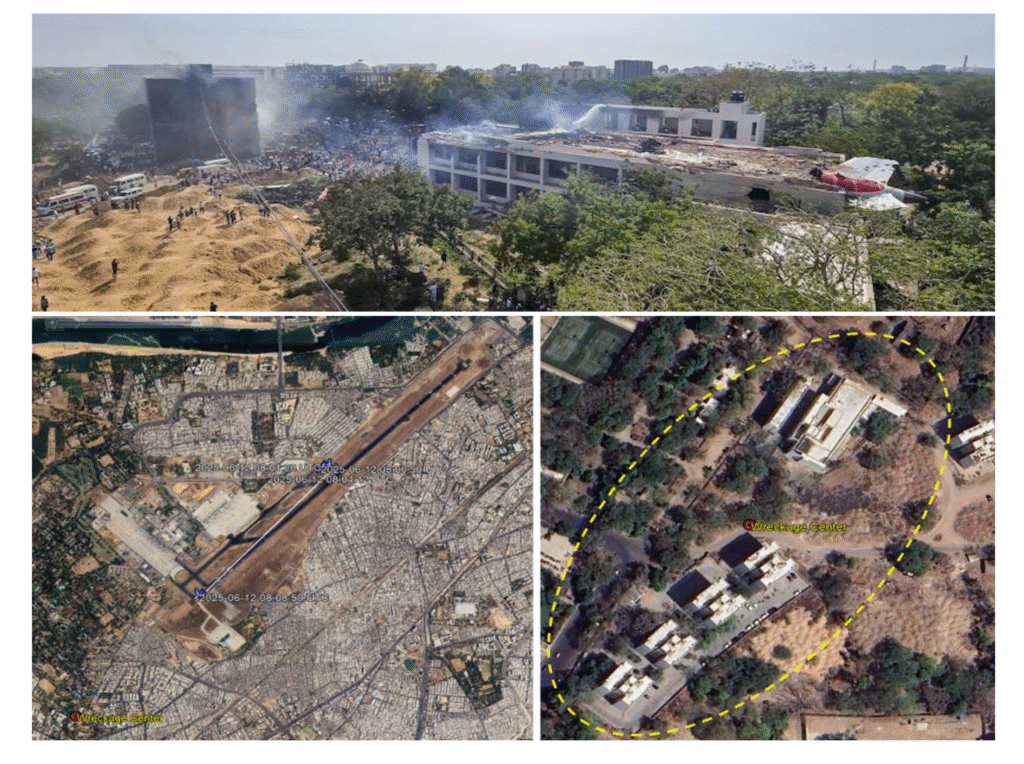Overview
On June 12, 2025, Air India Flight AI171, a Boeing 787-8 Dreamliner (VT-ANB), operating a scheduled passenger service from Ahmedabad to London Gatwick, crashed shortly after takeoff from Runway 23 at Sardar Vallabhbhai Patel International Airport, Ahmedabad.
- Time of accident: 13:39 IST (08:09 UTC)
- Occupants: 242 on board (230 passengers, 12 crew)
- Fatalities: 260 (all on board and 19 on ground)
- Injuries: 1 serious (passenger), 67 others on ground
Sequence of Events
- The aircraft took off at 08:07:37 UTC.
- As per flight recorder data, it reached rotation speed (Vr = 155 knots) at 08:08:35 UTC.
- Within 3–5 seconds of takeoff, both fuel control switches on the engines moved from RUN to CUTOFF, shutting off fuel supply.
- The engines began losing thrust, and the aircraft started losing altitude almost immediately.
- A MAYDAY call was made at 08:09:05 UTC.
- The plane crashed into the BJ Medical College hostel, just 0.9 nautical miles from the runway, impacting multiple buildings and catching fire.
Flight Crew & Aircraft Information
- Captain (56 yrs): 15,638 hours total flying experience, 8,260 hours on B787 as PIC
- Co-pilot (32 yrs): 3,403 hours total, 1,128 hours on B787
- Aircraft Build: 2013, total 41,868 hours flown
- Engines: GE GEnx-1B70; recently installed (May and Mar 2025)
- No known engine or fuel system defects before flight
What Went Wrong (So Far)?
The key technical anomaly reported:
Both engines’ fuel control switches were observed moving to CUTOFF in quick succession right after liftoff, without any command recorded or apparent mechanical trigger.
- Cockpit voice recording (CVR) captured a moment of confusion: One pilot asked, “Why did you cutoff?”
The other replied, “I didn’t.” - Engines began relight sequences and partially recovered (Engine 1 more successfully than Engine 2), but it was too late to regain control or altitude.
- The Ram Air Turbine (RAT) deployed, supplying limited hydraulic power, confirming the loss of main electrical systems.
Key Technical Notes
- No signs of bird strike, foreign object damage, or fuel contamination.
- The throttle levers were found in idle post-crash due to fire damage, but data shows they stayed in TO/GA position until impact.
- The landing gear never retracted.
- No issues were reported with flaps, flight control surfaces, or other critical systems.
- EAFR (black box) data from the forward unit was recovered and analyzed; aft unit was too damaged.
Maintenance & MEL
- Aircraft had 5 Minimum Equipment List (MEL) items active, none critical.
- A non-mandatory advisory (SAIB) about a similar fuel control switch locking issue on other Boeing models had not been acted upon, as it wasn’t a mandatory directive.
Aftermath
- Extensive damage to 5 buildings in the crash zone.
- Both engines were quarantined for detailed analysis.
- The flight data analysis, interviews, autopsy correlation, and more technical examinations are ongoing.
- No formal conclusions yet on whether this was a mechanical failure, human error, or system interaction issue.
What’s Next?
The investigation is being led by AAIB India, with active collaboration from:
- NTSB (USA) – as State of design
- Boeing, GE, FAA
- AAIB UK, Portugal GPIAAF, and Canada TSB – due to fatalities of foreign nationals
The final report will establish probable cause. For now, no global fleet actions have been recommended for Boeing 787 or GEnx engines.
Closing Thought
This incident is a heartbreaking reminder that even in one of the safest eras of aviation history, complex systems can fail in tragic, unforeseen ways. With hundreds of lives lost, including innocent people on the ground, the focus now must be on transparent, thorough investigation — not blame, but answers that prevent the next one.



















